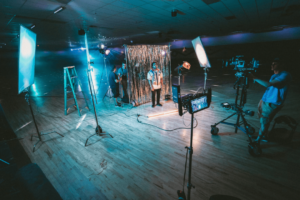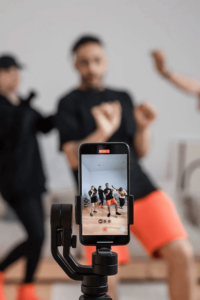The DJI Osmo Pocket gimbal camera is a good option if you are tired of taking shaky smartphone videos or want to increase the video quality on your vlog. The gimbal provides 3-axis mechanical stabilization, and the 12-megapixel camera can capture 4K video at up to 60 frames per second. Discover the compact marvel of technology with the Osmo Pocket.

The camera and gimbal combination may fit in most pockets, as the name implies. The device weighs 119 grams (approximately four ounces) and has a maximum battery life of 140 minutes.
You can also snap 12-megapixel single images, four- or nine-image panoramas, and video clips. A 1/2.3-inch sensor powers the wide-angle lens. Although the Osmo Pocket is not waterproof, the optional waterproof case allows you to shoot underwater. DJI produced a set of ND filters that attach straight to the wide-angle lens, and there is a magnetic strip for pairing other devices (yes, there is a selfie stick).

Mimo, the companion app, allows you to edit and share your film. It allows you to customize settings and includes features such as Story Mode, which turns individual footage into a little film. The app is compatible with Android and iOS, and Osmo Pocket doubles as a smartphone gimbal, which could come in handy if you are live streaming.
Osmo Pocket – Features
| Pros | Cons |
| 4K video capture at 60 fps | Audio doesn’t match video quality |
| Easy to start shooting | Not rugged at all |
| Time-lapse and panoramic stitching options. | One-inch screen is really tiny |
| Strong battery life. | Autofocus issues. |
| Motion-lapse is easy to use | So-so low-light performance. |
| Clever controls for such a small device | Requires phone or add-on control wheel for best experience. |
The handheld camera from DJI is far more suited to vlogging. Its long handle is meant to be grasped rather than attached to the side of a helmet, and its gimbal will not move properly if you don’t give it enough room. A couple of buttons – one multifunctional and the other for recording video and taking images — and a small one-inch touchscreen are located beneath the camera. A compact, removable pair of connectors (one USB-C and one Lightning) is also included with the camera. The Osmo Pocket may then be fastened to the bottom of a phone and held horizontally to manage the camera or transmit your footage using your phone’s touchscreen. The connector can be rotated so that it does not protrude when not used. As the one-inch screen is so small, it has a simple user interface built around four options that each swipe in from a different side.

You may utilize these to modify settings like the camera’s resolution or put it in selfie mode. Attempting to use a touchscreen of this size directly is a pain, as you’d expect from a device of this size. The menu options are small and difficult to tap precisely, and swiping the bottom menu upward when the phone connector attachment is put beneath it might be difficult. Thankfully, unless you are constantly switching resolutions or frame rates, most of the functions you wish to use can be accessed from the multifunction button, freeing up the screen for more minor adjustments like adjusting the part of the frame where you want the image exposed or selecting an object for the camera to keep in focus automatically.
The Osmo Pocket may be turned on and off by pushing the camera’s multifunction button once, twice, or thrice. Tapping it once switches between video and stills mode, two taps re-center the camera, and three presses flip it into selfie mode. There may likely be folks who require more instant access to the camera’s complex features. If you want quick access to the camera’s sophisticated features, connecting it to a smartphone is a terrific method. The only drawback is that this changes the Osmo Pocket from a gadget that can be operated with one hand to one that requires two hands to work efficiently. This trade-off is incomprehensible.
You can shoot in 10 seconds without a phone attached; utilizing a phone adds a couple of seconds to the setup time. The phone is smart enough to instantly open the DJI Mimo software when you hook the camera with an Android device (a Pixel 3). Although time-lapses, panoramas, and motion-lapses are available for those who want them, the Osmo Pocket is at its best when you’re just strolling around, shooting, and letting the three-axis gimbal do its thing.
You can try to keep your shots steady so they glide across space, but no matter how diligent you are, you will always be able to see the camera sway slightly with each step you take. If you do not put in enough effort, your footage will resemble a scene from a first-person shooting game, especially if you try running with the camera. The colors are vivid (if a touch oversaturated). When shooting in 4K, there is a tiny bit of noise, but the detail is normally good. The camera’s low-light performance, though, is not as impressive.
You can get away with aiming the camera at anything you want to capture and pushing the record button for the most part. However, you’ll still need to manually change settings to ensure your photo is not overexposed or underexposed. The Osmo Pocket can adjust between 30 and 60 frames per second, in addition to numerous resolutions. One of the main features of the Osmo Pocket is the aforementioned time-lapse feature. It may either pan between two points or execute a static time-lapse. The latter is surprisingly easy to set up; simply place the Osmo Pocket on a firm surface and move its gimbal to indicate the time-start lapse and end locations. The main issue is that the Osmo Pocket should not be held in this position. A wireless module provides the camera with a broader, more sturdy base and allows you to control the Osmo Pocket wirelessly from your phone, but it is an extra $100 attachment.
The Osmo Pocket can also film in slow motion, capturing 120 frames per second to make a 30 frames per second video. The Osmo Pocket has two microphones, one immediately above the recording button and the other on the bottom, and if you’re not cautious, you’ll rub your hand all over both as you change grip positions. It is reasonable to expect superior sound quality from the Osmo Pocket than from a conventional compact video camera, given how tailored it is toward the vlogging genre. DJI sells a small USB-C to microphone jack adapter for the camera, and USB-C microphones are also available. Before purchasing a third-party accessory for yourself, make sure it works.
Photographs can also be taken with the DJI Osmo Pocket. You can easily switch to this mode by pressing the multifunction button once. Given that snapping images is virtually an afterthought with a camera of this type. They are on par with a typical smartphone camera — but capturing them quickly is simple. If you are a serious photographer, you will probably do better with a professional camera. With the Osmo Pocket, it is particularly difficult to frame subjects properly. Not only was the camera’s screen small, but the stabilization made tilting the camera to ensure the scene was level difficult. Try tilting the camera to cancel the movement.
The Osmo Pocket from DJI performs a fantastic job of delivering on its form factor’s capabilities. It’s small and simple to use, and its video footage is of good quality. However, because of its price and lack of versatility, it is a more difficult camera to suggest than other portable video alternatives. It is not as tough as an action camera or as cheap as a standalone smartphone gimbal. You will want to put the case to good use as well. If there’s one major flaw with the Osmo Pocket design, it’s not quite as tough as a GoPro, which can withstand your daily grind. Maybe you are not very active and just drop things a lot. With the DJI’s smallest gimbal, that is not an option.
Here is something infinitely better than the GoPro design: we could export video and connect it to our smartphone as a viewfinder with a physical connection. The Osmo Pocket includes a universal port that accepts small Lighting and USB-C adapters. Slot one of these adapters into the port and instantly connect to an iPhone or Android phone. On the outside, the Osmo Pocket appears robust, but beneath the camera, hinges are sophisticated motors that must be protected from bumps, drops, and water. The DJI Osmo Pocket is an excellent example of a device tailored to a certain form factor. It is incredibly small for the job it does, and if that is your top priority, nothing else compares. However, if you do not require ergonomics or portability, you could be better off with a more general-purpose option.
According to DJI, the Osmo Pocket battery has a capacity of 875 mAh and can record for 140 minutes at 1080p 30fps. At full charge, our tests revealed that it met that requirement — with no gimbal movement. Choosing the superior 4K and rotating the gimbal around cut the battery life in half. However, in our real-world tests, it lasted an hour.
When the Osmo Pocket was first unveiled, the fact that the battery could not be replaced alarmed DJI fans. If you are on the fence, the battery, of all things, should not deter you. Perhaps durability, but not battery life. We recommend investing in one of the best portable batteries to keep the gimbal charged on the go.
Video: DJI Osmo Pocket Motion Lapse
The DJ Mimo App
While most of Osmo’s features may be used without a phone, a few require you to link the two. DJI Mimo is the companion software for Android and iOS devices that adds Story Mode to the pocket. The purpose of Story Mode is to let you create short, social media-friendly clips with automated cuts, audio tracks, and camera motions. There are a slew of templates available. Each template has a video lesson that is supposed to show you how to use it properly. Still, the tutorials are just short instances of how your Story will look regarding camera moves and editing. Similarly, the Story mode is plagued by a cardinal sin: baked-in advertising. The clips are watermarked with a DJI Osmo Pocket watermark, immediately making them less cool and more corporate. It’s impossible to turn it off. The resolution of stories is similarly constrained. Despite the camera’s support for 4K, they are limited to 1080p at 30 frames per second.

Some capabilities previously only available through the app, like Pro mode for 24fps capture, are now available without a phone. The pocket may switch off Pro mode after connecting to the Mimo app; to avoid this, simply turn on Pro mode in the app as well. Regardless of whether you utilize Pro mode, other capabilities are available in the app and the pocket. Panorama, Slow Motion, Time Lapse, and Motion Lapse are some options.
The Video Quality, Audio and Camera Specs
The secret to the DJI Osmo Pocket film looking so amazing is that it employs a camera sensor that keeps with (or is slightly larger than) the greatest camera phones of 2019, and it mounts it on an anti-shaky gimbal wand – a magic wand in the eyes of vloggers. It boasts a 1.2/3-inch sensor (Apple’s iPhone XS Max and Google’s Pixel 3 have 1/2.33-inch sensors), a 100Mbps maximum bitrate (your phone in 2019 is probably capped at 50Mbps), and an f/2.0 aperture. The result is 4K video with somewhat better quality than top-end smartphones, and it’s fully stabilized without relying only on optical image stabilization (OIS), electronic image stabilization (EIS), or a combination of the two.
The footage is more fluid and has less barrel distortion than the GoPro Hero 7. The Osmo Pocket doesn’t warp the corners despite having a narrower field of vision (80 degrees) and less color brightness than a GoPro or an Android smartphone. If you aim to capture yourself and the background, you might want to get an Osmo Pocket Extension Rod and put Cine Mode in the options menu to liven up otherwise blown-out skylines.
A DSLR and gimbal equipment that takes two hands would produce better video, but this is a more realistic alternative for most people who want smooth video for regular use. This flowing film frequently creates cinematic-looking vacation videos, time lapses, and brief establishing shots. These tasks are well within the capabilities of the Osmo Pocket. The audio quality is adequate but lacks the clarity that an additional microphone may provide. It will pick up your voice when you want to narrate or vlog because it faces the gimbal holder.
The Osmo Pocket can capture 4K or 1080p video at up to 60 frames per second, but you’ll need to use Pro mode to achieve the full range of frame rates. It can also take 12MP still photographs in Raw or JPG format. The video quality is excellent. It is not surprising: while DJI is best known for its drones, the quality of its cameras plays a big role in their success. The 4K footage from the pocket is crisp, vibrant, and detailed. There are fewer color profile selections than I would like to see—only Normal and D-Cinelike are available. Most people will use the former, whereas the latter takes video with reduced contrast and color saturation. For editors who desire color correction freedom, shooting video in this manner—with what’s known as a Flat Profile—is preferable. The low-contrast style brings out more details in the shadows and reduces blown highlights, giving you more options for your movie’s appearance.
Video: Insight on DJI Osmo Pocket
You must use the Mimo app to turn it on. If you want to film in black-and-white or with a more vibrant, saturated appearance as you can with a DJI drone, you’ll have to run the video through some other program. The autofocus system is a mixed bag. The pocket can be set to AF-S (fixed focus for the duration of a clip) or AF-C (changed focus for the duration of a clip), which you’ll want to use for any clips where the focus has to change. You’ll want to use it if you’re filming a travel movie that includes both selfie footage and images of the world around you; otherwise, either your face or distant landscapes will be dramatically out of focus. Because Osmo’s small screen makes it difficult to establish focus visually, its less-than-stable performance is a worry.
Dim lighting is also an issue. The pocket’s footage is extremely clear in strong sunlight, but inside films are grainy and soft. The audio quality is good—the built-in microphone picks up ambient noises. Professionals will want to use a wireless Lavalier or comparable microphone, and DJI plans to sell an adapter that will let them do so—it just has not been released yet. The image quality is comparable to that of a high-end smartphone. Of course, the pocket won’t be able to compete with a camera with interchangeable lenses. It doesn’t rely on computational photography as strongly as current phones like the Pixel 3 XL, but it does include automated panorama stitching. It takes advantage of the gimbal to keep the ISO low for low-light images, albeit you will need to photograph a static subject to avoid motion blur in lengthy handheld exposures.
Although the output resolution is limited (about 4MP), each original 12MP image is retained on the card, allowing you to stitch a full-quality photo in Photoshop if desired. Subject motion is difficult with all cameras that use multiple exposures for wide-angle panoramas. The pocket had no trouble stitching the static items in this metropolitan picture, but vehicles and pedestrians were a different story.
Drawbacks of Being the First One
The DJI Osmo Pocket is a new gadget with some first-generation issues to work out. It is not the first portable gimbal we’ve seen, nor the first with a built-in camera. However, it is one of the smallest, and its built-in camera is better suited for vlogging and handheld video than the reused drone camera used in Osmo’s first version from a few years back.
Although the Osmo Pocket’s camera significantly improved over the original regarding close focus capability, its autofocus is slower and less reliable than my iPhone’s. To compete in a world where everyone who spends enough money on a flagship smartphone has a highly powerful 4K video camera at all times, the pocket must be flawless.
However, it is not quite there. The video looks amazing in strong light, but in low light, it struggles, and focusing performance is a major worry. You are unlikely to detect misfocused images on the pocket’s small screen, so you are stuck with the ergonomically unpleasant task of plugging in your phone to ensure you get exactly what you want.
In the interim, there are numerous things DJI might do to improve the Pocket experience through firmware updates. It’s already released one major update, so we’ll see whether there are any more improvements. Bundling the Control Wheel with the other promised accessories would also be beneficial. The pocket is a prototype that is being sold as a finished item. You should consider adding it to your kit if you’re enthused enough to put up with the first-generation growing pains, but if you are on the fence, you should wait until DJI has more time to perfect it.
Accessories for Osmo Pocket
Here are a few of the accessories:
DJI Osmo Pocket Control Wheel
Use the Control Wheel to achieve the finest pan and tilt motion while filming video. Due to the tiny factor, a linear control design makes maintaining a consistent side-to-side or up-and-down transition easier. A switch allows you to swap between the two linear orientations. Two additional buttons, one for re-centering the camera and the other for turning the camera 180 degrees, are included in the accessory. If you don’t have the Control Wheel, you’ll have to double-click the power/mode button to re-center the camera and three times to flip it. The regular gimbal buttons were soft and mushy, with no tactical confirmation for multiple presses. Thus, the extra hard selfie and re-center buttons on the Control Wheel made life easy.
Wireless Module
Unless you have this Bluetooth and Wi-Fi base, you won’t be able to wirelessly share video and photographs or use your smartphone as a remote viewfinder. This took us aback, but we often carried this tiny base. It’s perfect for time-lapses and motion time-lapses since it makes the top-heavy gimbal easier to stand up.
You will need the side-mounted USB-C port for constant charging if you’re planning to record long time lapses (the Osmo Pocket can record up to five hours of moving time lapses and never-ending regular time lapses). Due to the bottom USB-C connector, powering the Osmo Pocket without this adaptor is nearly impossible.
One gripe: the USB-C port on the Module is on the other side of the one-inch screen. The brilliant screen is more likely to reflect when you place the Osmo Pocket against a window with the USB-C cable dangling down the other side.
Waterproof Case
This waterproof case keeps the gimbal dry in an underwater snuba excursion, far beyond scuba diving depths. The camera picks up the hard edge that encircles this window if it moves off-center. The touchscreen is not accessible via the plastic casing. With two presses of the case’s two buttons, you can cycle through modes, tap record, and re-center the camera with only two presses. This would have worked much better if the case had a bubble dome form. When underwater, use a GoPro or the DJI Osmo Action.
Accessory Mount
The gimbal-hugging accessory cradle and twist-lock connector allow the Osomo Pocket to be attached to current GoPro mounts. This is the ideal way to keep the camera tight when mounting it to a Peak Design Capture Clip for usage on a belt or backpack or when sticking it on a helmet. It is a workaround for not having a tripod mount.
3.5mm Adapter
The DJI Osmo Pocket microphone is merely adequate. The first big software upgrade improved things, and we like how the microphone is close to the screen, pointing at the narrator or vlogger. However, you will need a 3.5mm adaptor if you want everyone to hear you. Although DJI manufactures one, we discovered that any old USB-C to 3.5mm converter will suffice.
Extension Rod
Although we could not test out the extension rod or selfie stick that DJI sells, it compensates for the camera’s short focal length and lack of a tripod mount. It has an extendable length, a gimbal control stick, handle buttons, and a 1/4-inch tripod mount on the bottom.
Purchase Link: Osmo Pocket Extension Rod
Charging Case
The ideal high-end case for the DJI Osmo Pocket is a charging case, not the cover that comes with it. It has more robust protection, a built-in battery, and room for two microSD cards, four ND filters, two smartphone connectors, and a built-in battery. It sounds like a great travel companion if you have the space, only for the extra juice.
ND Fillers Set
DJI has released a set of Neutral Density filters for purchase. They restrict the quantity of light that enters the sensor, resulting in fewer overexposed images and the possibility of improving motion blur effects. Third-party filters are less expensive than DJI’s $55 asking price, but read customer reviews to be sure they’re good. The fit and quality of a garment might vary substantially.
Conclusion
The DJI Osmo Pocket is a camera gimbal that can go almost anywhere and record anything, providing stabilized footage that rivals top-of-the-line smartphones. You can shoot 4K at 60fps film that glides fluidly like an old-school Hollywood crane and motion time lapses that seem like what the pros can produce with far more expensive camera equipment.
A DSLR or mirrorless camera with a huge gimbal or a motorized panoramic time-lapse tripod head will produce superior results. However, the quality variations are modest, and the Osmo removes significant weight and equipment from your camera bag. That’s where YouTubers and consumers who want great vacation videos without the normal shakiness will find it a wonderful deal.










